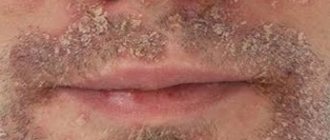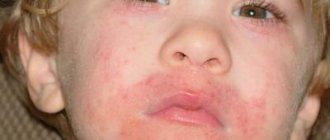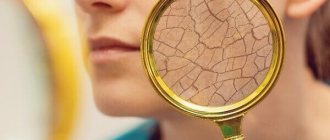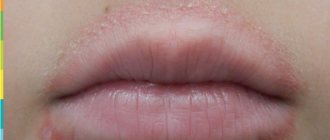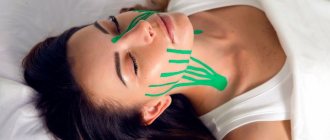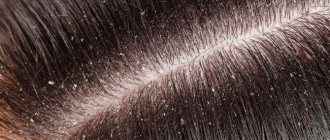Seborrheic dermatitis in the photo
Photo 1. Seborrheic dermatitis of the scalp.
Photo 2. Seborrheic dermatitis of the head.
Photo 3. Photo of seborrheic dermatitis before treatment.
Photo 4. Photo of seborrheic dermatitis after treatment.
Photo 5. Symptoms of seborrheic dermatitis: redness and peeling.
Photo 6. Symptoms of seborrheic dermatitis: the appearance of crusts.
Preparations and regimens for use for dandruff and seborrhea
Scheme 1: Oily scalp and dandruff.
1. Option a. Anti-dandruff cream shampoo No. 19 b. Dermocapillary mask No. 58 (28) once a week after shampoo for 10 minutes. V. Balm 12 herbs No. 46 (70) 3 times a week. within 2-3 months.
2 options. Shampoo No. 17 (for oily hair) b. Dermocapillary mask No. 58 (28) once a week after shampoo for 10 minutes. V. Herbie lotion No. 3 (25) 3 times a week. within 2-3 months.
3 Option a. Shampoo No. 142 (Dixidox). b. Anti-dandruff gel No. 100B 2 times a week. before shampoo for 20 minutes. V. Dermacapillary mask No. 58 (28) once a week after shampoo for 10 minutes
Seborrheic dermatitis on the scalp and sebaceous glands
The secretion of the sebaceous glands is a mixture of lipids and is called sebum. It is necessary for the healthy functioning of the skin: moisturizing it, maintaining elasticity, creating an antimicrobial protective barrier.
The skin is covered unevenly with sebaceous glands; there can be from 4 to 380 ducts per 1 cm2. They lie in the middle layer of the skin - the dermis, between its papillary and reticular layers. The largest number of sebaceous glands are located in the so-called “seborrheic zones”: on the skin of the face and body (back, neck, scalp, pubis, chest, abdomen, shoulders, forearms, legs). There are no sebaceous glands on the skin of the soles and palms.
For the most part, the ducts of the sebaceous glands open at the mouths of the hair follicles. In smaller numbers, the excretory ducts open directly onto the surface of the epidermis - in the area of the eyelids, borders of the lips, external auditory canal, nipple halos, and anus.
The size of the glands and the amount of lipid secretion depends on various factors: the functioning of the endocrine, nervous, reproductive systems of the body, age. In young children, the sebaceous glands secrete very little secretion. By adolescence, their work increases sharply, but as they grow older, their activity decreases. In adult men, sebum is constantly secreted in approximately the same amount; in women, this process is often associated with the menstrual cycle. In old age, the amount of secretion released decreases.
Treatment of oily and dry seborrhea on the face
In the NEARMEDIC network of clinics, individuals have a comprehensive approach to the treatment of seborrhea. Therapy includes:
- use of special cosmetics to care for problem skin;
- restoring the balance of the body by taking vitamins and minerals;
- diagnosis and treatment of the causes of the disease;
- treatment of complications that arise after seborrhea.
The main goals of treating seborrhea on the face are:
- normalization of the nervous system;
- restoration of the endocrine system;
- activation of metabolic processes.
In each case, our specialists select individual treatment tactics.
Seborrheic dermatitis. Varieties
Oily seborrhea is the most common type of disease. It is characterized by increased secretion of sebum and changes in skin microflora. With oily seborrhea, redness of the skin or small reddish papules with an oily sheen and clearly defined boundaries are observed. Oily seborrhea, in turn, is divided into thick and liquid, depending on changes in the composition of the skin secretion (see photo of seborrheic dermatitis).
Oily seborrhea
Oily seborrhea
With liquid seborrhea, the level of free fatty acids in sebum increases. The skin of the face becomes shiny, rough, with enlarged pores. Comedones and acne easily form on it. If liquid seborrhea affects the scalp, the hair looks very dirty and sticks together in strands.
With thick seborrhea, there is a decrease in the level of lower fatty acids and an increase in higher fatty acids in the sebum. An imbalance in the composition of skin secretions reduces its protective properties and provokes the proliferation of microorganisms. Externally, thick seborrhea can manifest itself as pustular rashes, dilation of the mouths of the ducts of the sebaceous glands, comedones, and the separation of large yellowish scales glued together.
Dry seborrhea - often observed in young children, as they produce an insufficient amount of skin secretion. In adults, the dry form of seborrheic dermatitis occurs less frequently. It is characterized by a decrease in sebum production, dryness, cracks and excessive flaking of the skin, a feeling of tightness that intensifies after contact with water. The hair on the head becomes thinner, brittle and split. In some cases, the scales layer on top of each other, forming crusts. Acne, pink and red spots appear on the skin.
Dry seborrhea
Severe seborrhea with infection
Mixed seborrhea - characterized by the simultaneous appearance of dry seborrheic dermatitis on the scalp and oily seborrheic dermatitis on the face.
Prevention of seborrhea on the face
Dermatologists at the NEARMEDIC clinic recommend:
- exclude sweet, spicy, salty, seasonings, alcoholic and carbonated drinks from the diet, so as not to provoke increased sebum production;
- cleanse your face every day with special lotions;
- use only medicinal cosmetics that suit you;
- spend more time in the fresh air;
- Avoid prolonged exposure to the scorching sun. In small doses this can even lead to improvement, but in large doses it can lower the skin’s immunity and contribute to the spread of infection.
And, of course, strictly follow all the recommendations of your doctor!
Seborrheic dermatitis. Symptoms
Seborrheic dermatitis can develop both in the head and torso. Seborrhea of the scalp can manifest itself as inflammation of the scalp, eyebrows, eyelashes, hairline, nasolabial folds, external auditory canals and the area behind the ears. In men, it is often localized in the area of beard and mustache growth.
Seborrheic rash can also affect the chest and natural folds of the body: armpits, groin, abdomen, mammary glands. Seborrhea of the face and body manifests itself as red spots, accompanied by itching and peeling, a burning sensation and even the appearance of papules, merging into ring-shaped or garland-shaped plaques. The plaques have clear boundaries, the papules are covered with fatty yellowish scales. As the disease progresses, bright yellow crusts appear on the skin, inflammation grows over a large surface area of the skin, and a bacterial infection occurs.
Seborrheic dermatitis of the scalp is characterized by the detachment of whitish scales, which can be mistaken for large dandruff. However, unlike dandruff, seborrhea is accompanied by itchy skin, and the lesions are clearly visible. Many patients associate dry scalp with the appearance of “dandruff”, so they wash their hair less often. Unfortunately, such tactics, instead of the desired result, only lead to the accumulation of seborrheic scales, the formation of dense crusts and pathological inflammation of the scalp and sebaceous glands. Refusal of treatment leads to thinning hair and baldness.
Seborrhea of the scalp in infants usually appears at the age of 3 months. It consists of thick yellow crusts that can be easily removed with vegetable oil and does not bother children. However, the combination of skin rash with diarrhea and underweight in newborns requires urgent medical attention, as it may indicate the presence of such a serious disease as Leiner's erythroderma.
Oily seborrhea
Most often, seborrhea occurs as an oily type. There is an increase in the secretion of the sebaceous glands. Hair quite quickly, often already on the second or third day after washing, becomes greasy, shiny, takes on an unkempt appearance, and sticks together in greasy strands. Dandruff forms on the scalp from greasy flakes, which easily comes off when scraped.
Hair loss gradually increases , ending in a relatively short time (3–5 years, sometimes more) with significant baldness. This disease is accompanied by severe itching, dandruff flakes stick together, forming gray-yellowish plaques on the hair, falling from the hair to the shoulders, giving clothes an unkempt appearance.
Seborrheic dermatitis. Causes
The main reason for the development of seborrhea is the effect on the skin of opportunistic yeast-like lipophilic fungi Malassezia furfur, which are present in varying quantities in most people. The oval form of the fungus (Pityrosporum ovale) is responsible for the development of inflammation of the scalp. Lesions on the skin of the body are caused by the round form of Malassezia furfur – Pityrosporum orbiculare. Fungi create colonies around the ducts of the sebaceous glands, feeding on lipid secretions and actively multiplying.
However, seborrheic dermatitis does not affect everyone. Thanks to the immune system, a healthy body inhibits the growth of fungi. If the body's metabolism is disrupted, Malassezia furfur begins to multiply uncontrollably, which breaks down sebum into free fatty acids, which causes inflammation.
The development of pathology can occur due to the following factors:
- puberty - due to hormonal changes in adolescents, the composition of sebum changes, and the sebaceous glands begin to work with greater intensity. In this case, the disease goes away on its own as the patient grows older;
- hereditary predisposition explaining the hyperfunction of the sebaceous glands;
- hormonal imbalance, in which there is an increase in the level of androgen and progesterone and a decrease in estrogen levels. Hormone-dependent seborrheic dermatitis is observed in women in menopause or with ovarian diseases, in men with testicular tumors, and in obesity;
- unhealthy diet with an abundance of spicy, salty and fatty foods;
- presence of bad habits (alcohol, tobacco smoking);
- infectious diseases, weakened immunity;
- stress and overwork;
- non-infectious diseases of the gastrointestinal tract, endocrine system and metabolism. Painful conditions are accompanied not only by increased work of the sebaceous glands, but also by excessive sweating and cardiac arrhythmia;
- psychological and mental diseases (for example, Itsenko-Cushing syndrome, schizophrenia, epilepsy, manic-depressive disorder), in which the functions of the pituitary gland and hypothalamus are disrupted.
But despite the extensive list of possible reasons, none of them are absolute. The exact reason contributing to the excessively active activity of Malassezia fungi has not yet been identified.
Types of dandruff
Dry dandruff
– caused by decreased sebum secretion (too dry skin). In this case, dandruff flakes are small in size, easily come off the skin, and a “powdered” effect is observed on the hair. Most often they are located along the entire length of the hair; lesions form quite rarely.
Oily dandruff
– this disorder occurs with increased sebum secretion. Dandruff flakes are large, stick together and attach to the hair. They peel off more easily than dry ones. With such dandruff, the hair quickly becomes oily and the patient feels constant itching.
